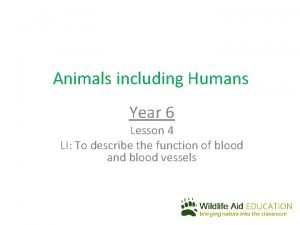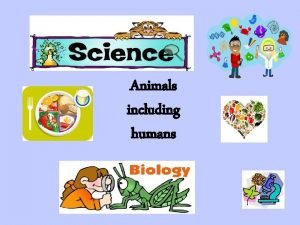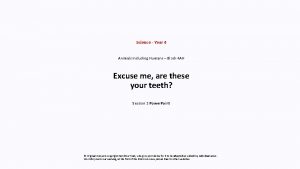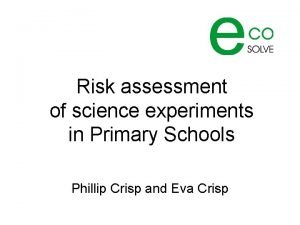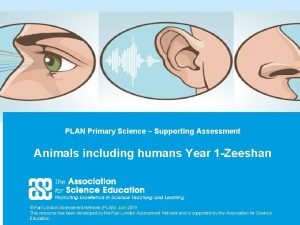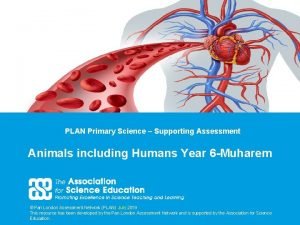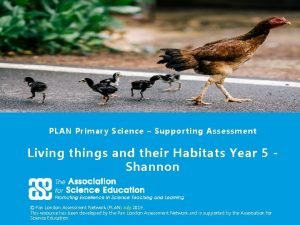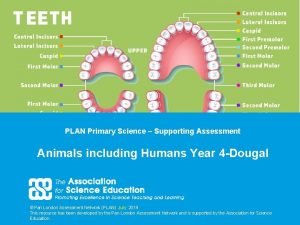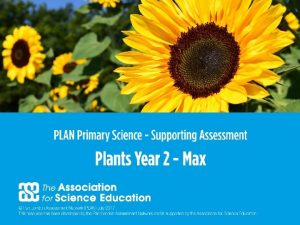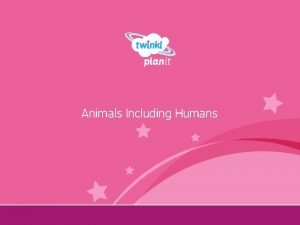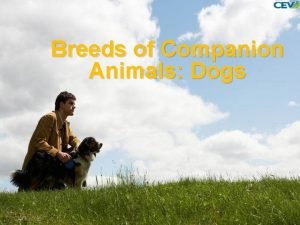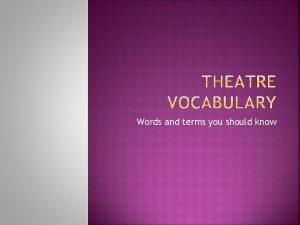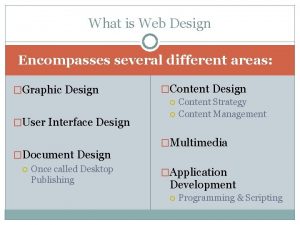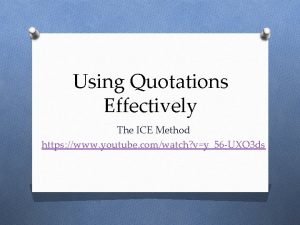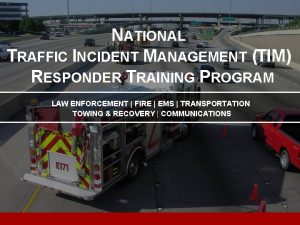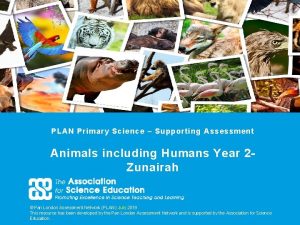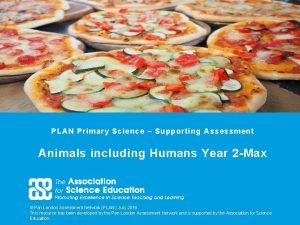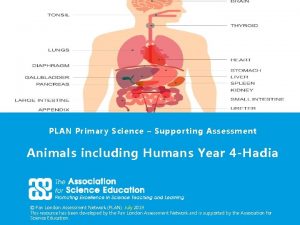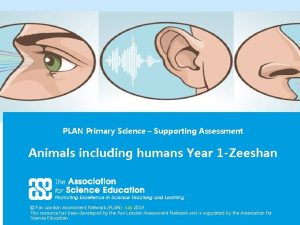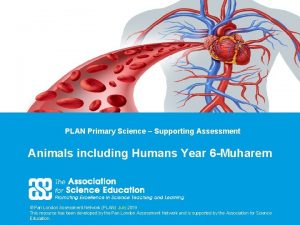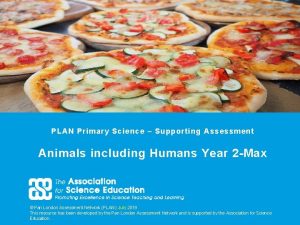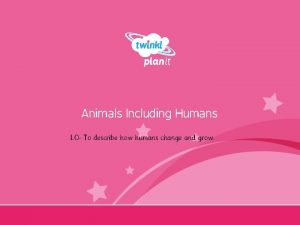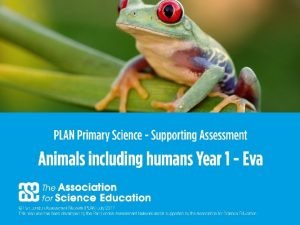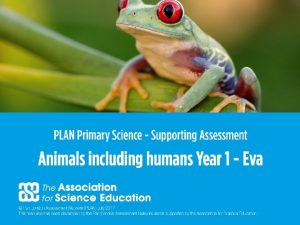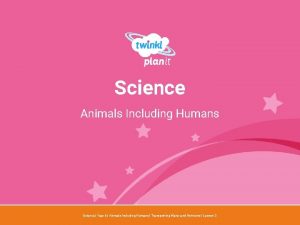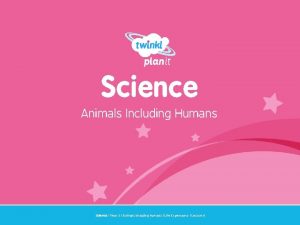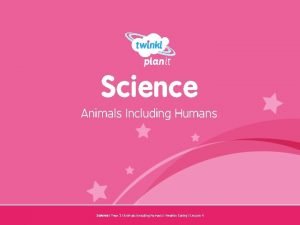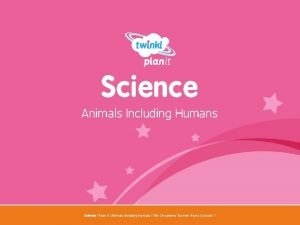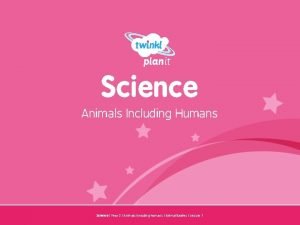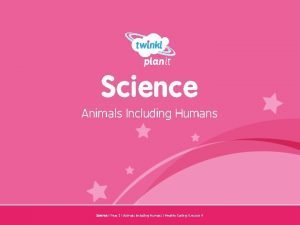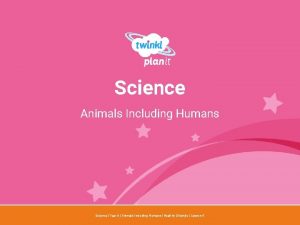PLAN Primary Science Supporting Assessment Animals including Humans























- Slides: 23

PLAN Primary Science – Supporting Assessment Animals including Humans Year 3 Amelie © Pan London Assessment Network (PLAN) July 2019 This resource has been developed by the Pan London Assessment Network and is supported by the Association for 1 Science Education.

PLAN Primary Science - Supporting Assessment PLAN Primary Science is a set of resources produced to enable teachers to have a clearer understanding of National Curriculum expectations for meeting the standard. Annotated collections of children’s work provide examples of what working at the expected standard for primary science might look like for the knowledge and conceptual understanding statements of the programmes of study (POS). It is not the intention of these resources to specifically exemplify the working scientifically statements. However, aspects of working scientifically have been shown as an integral part of the teaching and learning of the knowledge and concepts. The resources provided have been cross moderated multiple times before publishing so that they can be used with confidence by teachers and subject leaders. Each collection of work shows one example of how a pupil has met National Curriculum statements for a particular area of content but these are not intended to be the definitive way of teaching these statements. 2

Structure of the resources Each resource contains the relevant National Curriculum statements for the unit of work and prior learning, a planning matrix, annotated work and a summary sheet. The matrix provides an interpretation of the key learning of the National Curriculum statements, and suggestions of key vocabulary. In order to be meet the expectations pupils must firstly understand the key concept and then be provided with opportunities to apply that knowledge. This is a key planning tool. Key Learning Secure Possible Evidence Show Overview paragraph describing understanding of a curriculum concept by using scientific Key vocabulary – list of words vocabulary correctly Possible ways to demonstrate key learning, particularly correct usage of vocabulary Apply knowledge in familiar related contexts Possible ways to demonstrate that a pupil has gone beyond recall of facts and can apply the key learning, for example using the vocabulary and basic principles to produce explanations, usually within Working Scientifically contexts. Suggestions of contexts to use. 3

Contents of the materials Please note: The NC statements for each topic area for the relevant year group are stated on the slide. Only the statements in bold on that slide have been exemplified. In these cases the teachers have chosen to split the statements within the topic area to teach at different times. The prior NC statements relevant to the topic area are also stated and use to determine pupils’ knowledge at the start of the unit. Each slide has been annotated with coloured text. Please see key below: Red Commentary to explain how evidence meets/does not meet NC statements Blue Commentary to highlight features of working scientifically Green Pupil Speak Grey Other relevant information eg. vocabulary used 4

Prior Learning - Year 1 Statements Pupils should be taught to: • identify and name a variety of common animals including fish, amphibians, reptiles, birds and mammals (1 -Animals, including Humans) • identify and name a variety of common animals that are carnivores, herbivores and omnivores (1 Animals, including Humans) • describe and compare the structure of a variety of common animals (fish, amphibians, reptiles, birds and mammals, including pets) (1 -Animals, including Humans) 5

Prior Learning - Year 2 Statements Pupils should be taught to: • notice that animals, including humans, have offspring which grow into adults (2 -Animals, including Humans) • find out about and describe the basic needs of animals, including humans, for survival (water, food and air) (2 -Animals, including Humans) • describe the importance for humans of exercise, eating the right amounts of different types of food, and hygiene (2 -Animals, including Humans) 6

Year 3 Statements Pupils should be taught to: • identify that animals, including humans, need the right types and amount of nutrition, and that they cannot make their own food; they get nutrition from what they eat (3 -Animals, including Humans) • identify that humans and some other animals have skeletons and muscles for support, protection and movement (3 -Animals, including Humans) 7

Later Statements Pupils do not need to be taught content they will learn in later year groups. They can be challenged by applying the content for their year group in broader contexts. Pupils in Year 4 will be taught to: • describe the simple functions of the basic parts of the digestive system in humans (4 -Animals, including Humans) • identify the different types of teeth in humans and their simple functions (4 Animals, including Humans) • construct and interpret a variety of food chains, identifying producers, predators and prey (4 -Animals, including Humans) Pupils in Year 6 will be taught to: • identify and name the main parts of the human circulatory system, and describe the functions of the heart, blood vessels and blood (6 -Animals, including Humans) • recognise the impact of diet, exercise, drugs and lifestyle on the way their bodies function (6 -Animals, including Humans) • describe the ways in which nutrients and water are transported within animals, including humans (6 -Animals, including Humans)

SECURE Assessment guidance Key learning Possible Evidence Shows understanding of a Animals, unlike plants which can make their own food, need to eat in concept using scientific order to get the nutrients they need. Food contains a range of different vocabulary correctly nutrients that are needed by the body to stay healthy – carbohydrates including sugars, protein, vitamins, minerals, fibre, fat, sugars, water. A piece of food will often provide a range of nutrients. Humans and some other animals have skeletons and muscles which help them move and provide protection and support Key vocabulary: Nutrition, nutrients, carbohydrates, sugars, protein, vitamins, minerals, fibre, fat, water, skeleton, bones, muscles, support, protect, skull, ribs, spine, muscles, joints Can name the nutrients found in food Can state that to be healthy we need to eat the right types of food to give us the correct amount of these nutrients Can name some bones that make up their skeleton giving examples that support, help them move or provide protection Can describe how muscles and joints help them to move Applying knowledge in familiar related contexts, including a range of enquiries Can classify food into those that are high or low in particular nutrients Can answer their questions about nutrients in food based on their gathered evidence Can talk about the nutrient content of their daily plan Use their data to look for patterns (or lack of) when answering their enquiry question Can give similarities e. g. they all have joints to help the animal move, and differences between skeletons Classify food in a range of ways Use food labels to explore the nutritional content of a range of food items Use secondary sources to find out they types of food that contain the different nutrients Use food labels to answer enquiry questions e. g. How much fat do different types of pizza contain? How much sugar is in soft drinks? Plan a daily diet contain a good balance of nutrients Explore the nutrients contained in fast food Use secondary sources to research the parts and functions of the skeleton Investigate pattern seeking questions such as Can people with longer legs run faster? Can people with bigger hands catch a ball better? Compare, contrast and classify skeletons of different animals

Initial activity to assess prior learning The children were asked to talk to their partner about what they had learnt about animals and humans in year 2. They were given a few key words to help them remember – food, water, exercise, survive, healthy, rest The writing covered was added at the end of the learning We need to eat healthily, so we don’t get sick. We can’t just eat one thing, we need lots of different things. We would die if we didn’t drink water. All animals sleep. Even my dog sleeps. We need to exercise. I swim 5 or 4 times a week so I am healthy. During the initial talk Amelie demonstrated that she was secure with the year 2 statements. The children were then asked to record their understanding as a concept map and then think of some questions. Amelie’s questions are all relevant to the topic of humans.

Researching nutrients • identify that animals, including humans, need the right types and amount of nutrition, and that they cannot make their own food; they get nutrition from what they eat The children were given the keywords - carbohydrates, proteins, fats, fibre, minerals and vitamins to research. After their research the children were asked to complete the appropriate nutrient into the first column of the table. This information is not necessary for the children to recall as it is beyond the Year 3 statements From her research Amelia correctly places the nutrients in the correct place in the table. This is insufficient evidence to show that she is yet secure. She needs to apply this knowledge in context.

Identifying the nutrients in their favourite meal • identify that animals, including humans, need the right types and amount of nutrition, and that they cannot make their own food; they get nutrition from what they eat The children were asked to draw their favourite meal and then annotate it to show what nutrients they would gain from each food item. I need something that is protein (adds chicken to the plate. I like rice. That’s carbohydrates Amelia uses appropriate key vocabulary – carbohydrates and protein Amelia is not referring to the nutrients here but the food types from year 2. Amelie is not consistent in distinguishing between food types (dairy, fruit and vegetables) and nutrients (carbohydrates, protein etc. ) This needs further reinforcement.

Odd one out activity • identify that animals, including humans, need the right types and amount of nutrition, and that they cannot make their own food; they get nutrition from what they eat The children were shown three images of food and asked to think about which one they thought was the odd one out and why Maybe the pasta because the other two contain vegetables. The pizza has tomatoes and pineapple. The pasta and the pizza contain carbohydrates. The past and pizza both have cheese which is fat and protein. Amelie is beginning to talk more confidently about nutrients.

Investigating food packaging • identify that animals, including humans, need the right types and amount of nutrition, and that they cannot make their own food; they get nutrition from what they eat The children were given some food packaging and asked to sort it according to how much fat and then sugar they contained. They were then shown the food labels and their attention was drawn to the column that displays content per 100 g so that they could compare food items. Amelie’s group sorted the food into two groups – low fat and high fat. They then ranked them in order of sugar content. Even the roast chicken contains sugar. Amelie is aware that fats and sugars are contained in many different types of food, which is not always expected.

Mc. Donalds Nutrition calculator • identify that animals, including humans, need the right types and amount of nutrition, and that they cannot make their own food; they get nutrition from what they eat The children were shown how to use the Mc. Donalds nutrition calculator. They were then asked to select one nutrient and compare this across some of the Mc. Donalds products. Amelie and her group chose to look at the fat content. I can’t believe there is more fat in the salad than the hamburger. It must be in the dressing. Amelie’s comment shows that she understandably expected the fat content of the salad to be lower than the other items. She was able to adjust her thinking to take account of the data she gathered and give a reason for its high value.

Identifying the nutrients in a pizza • identify that animals, including humans, need the right types and amount of nutrition, and that they cannot make their own food; they get nutrition from what they eat The children were given a pizza to cut up and then consider what nutrients were provided by each slice. Pineapple. That is vitamins and minerals. Ham. I think its meat. It’s protein. She then pointed to - cheese which is fats and said the red stuff is tomatoes. I think that’s minerals. The teacher asked, “What about the base of your pizza? ” Bread which is carbohydrate. Second child cutting a pepperoni pizza. Amelie responded Pepperoni is a protein. Amelie is now secure with identifying the nutrients from different types of food.

Researching the names of bones in the human skeleton • identify that humans and some other animals have skeletons and muscles for support, protection and movement. After looking at a human skeleton and trying to count the bones, the children were asked to research how many bones are in a human skeleton and to label the bones with post it notes. The children were then asked to annotate the diagram with the bones they could remember from their research. My ribs make space for me to breathe, when I’m underwater. Otherwise my body would get squashed. Amelia correctly labels many of the bones in the human skeleton. At present she is not aware of the functions of the skeleton.

Discussing a concept cartoon • identify that humans and some other animals have skeletons and muscles for support, protection and movement. The children were shown the concept cartoon from Spellbound Science and asked to consider whether Ricky would be better off without any bones. If I didn’t have bones I’d be all squidgy and I wouldn’t be able to run or stand up. It would be easier to damage things on the inside because the bones wouldn’t be there to stop things from hurting us. He said you could move better but you can’t because you’d be flat on the floor. Your bones help you move. Amelie shows an understanding of the three functions of the skeleton.

Exploration of how they move their bodies • identify that humans and some other animals have skeletons and muscles for support, protection and movement. The teacher explained that we can move our bodies where there are joints between two bones. The children were asked to find joints on their bodies and then to consider whether all joints moved in the same way. At my shoulder my arm can go round but at my elbow it just goes up and down. The children were shown a video clip explaining how the muscles at a joint move the bones. The children then created models using elastic bands and card. My muscles help my bones to move where I want them to. Amelie is beginning to understand that bones and muscles work together to move the body.

Odd one out discussion • identify that humans and some other animals have skeletons and muscles for support, protection and movement. The children were shown images of three animals and asked to decide which one they though was the odd one out giving a reason. The ladybird is the only one with wings. The giraffe has a skeleton like us. The others don’t. The octopus has suckers. They were then asked to discuss how the ladybird and octopus could move, support and protect itself without a skeleton. The ladybird has legs. The octopus has muscles in its arms that help it to move through the water. It can squirt black stuff to hide in, like in Finding Nemo when she gets scared. Amelie shows awareness that not all animals have skeletons but that they can still move and protect themselves.

Final assessment activity The children were asked revisit their concept map from the beginning of the topic and add any additional learning. They also answered their questions with a quick bit of research. Amelie now confidently writes about the different nutrients. She has learnt more than is required at this stage as she also knows how the nutrients benefit the body. This is key stage 3). She understands how muscles and bones work together to help us to move. She is confident with planning a healthy diet.

Overall Summary - Secure Through a range of different activities, Amelie becomes familiar with the different nutrients and identifies what types of food they each come from. She names bones in the skeleton and understands that this has three functions – support, protection and movement. She knows that the bones and muscles work together to make her move. She can talk about how other animals can move and protect themselves without skeletons. 22

Acknowledgements Slide 13 – Spellbound Science Millgate House 23
 Animals including humans year 6
Animals including humans year 6 Animals including humans
Animals including humans Animals including humans year 4
Animals including humans year 4 Science experiment risk assessment
Science experiment risk assessment Plan primary science
Plan primary science Plan primary science
Plan primary science Plan primary science
Plan primary science Digestive parts
Digestive parts Plan primary science
Plan primary science My favourite subject computer
My favourite subject computer Https//a-z-animals.com/animals
Https//a-z-animals.com/animals Producers consumers and decomposers
Producers consumers and decomposers Parasitic food chain
Parasitic food chain Animals that eat both plants and animals
Animals that eat both plants and animals Primary and supporting instruments
Primary and supporting instruments Attitude instrument flying
Attitude instrument flying Primary consumers
Primary consumers Primary consumer animals
Primary consumer animals Breeds of companion animals dogs
Breeds of companion animals dogs The primary pigment colors are ____.
The primary pigment colors are ____. Printed words including dialogue
Printed words including dialogue It encompasses several different aspects, including
It encompasses several different aspects, including I.c.e. method
I.c.e. method The mutcd recommends the use of emergency vehicles
The mutcd recommends the use of emergency vehicles
